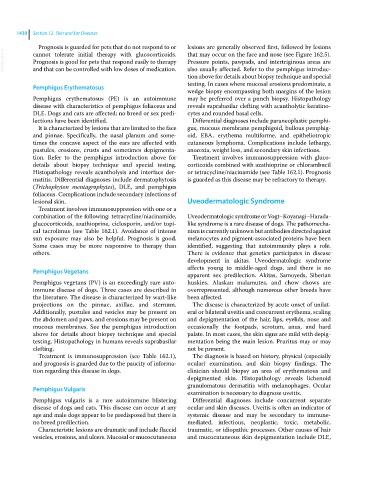Page 1492 - Clinical Small Animal Internal Medicine
P. 1492
1430 Section 12 Skin and Ear Diseases
Prognosis is guarded for pets that do not respond to or lesions are generally observed first, followed by lesions
VetBooks.ir cannot tolerate initial therapy with glucocorticoids. that may occur on the face and nose (see Figure 162.5).
Pressure points, pawpads, and intertriginous areas are
Prognosis is good for pets that respond easily to therapy
also usually affected. Refer to the pemphigus introduc-
and that can be controlled with low doses of medication.
tion above for details about biopsy technique and special
testing. In cases where mucosal erosions predominate, a
Pemphigus Erythematosus
wedge biopsy encompassing both margins of the lesion
Pemphigus erythematosus (PE) is an autoimmune may be preferred over a punch biopsy. Histopathology
disease with characteristics of pemphigus foliaceus and reveals suprabasilar clefting with acantholytic keratino-
DLE. Dogs and cats are affected; no breed or sex predi- cytes and rounded basal cells.
lections have been identified. Differential diagnoses include paraneoplastic pemphi-
It is characterized by lesions that are limited to the face gus, mucous membrane pemphigoid, bullous pemphig-
and pinnae. Specifically, the nasal planum and some- oid, EBA, erythema multiforme, and epitheliotropic
times the concave aspect of the ears are affected with cutaneous lymphoma. Complications include lethargy,
pustules, erosions, crusts and sometimes depigmenta- anorexia, weight loss, and secondary skin infections.
tion. Refer to the pemphigus introduction above for Treatment involves immunosuppression with gluco-
details about biopsy technique and special testing. corticoids combined with azathioprine or chlorambucil
Histopathology reveals acantholysis and interface der- or tetracycline/niacinamide (see Table 162.1). Prognosis
matitis. Differential diagnoses include dermatophytosis is guarded as this disease may be refractory to therapy.
(Trichophyton mentagrophytes), DLE, and pemphigus
foliaceus. Complications include secondary infections of
lesional skin. Uveodermatologic Syndrome
Treatment involves immunosuppression with one or a
combination of the following: tetracycline/niacinamide, Uveodermatologic syndrome or Vogt–Koyanagi–Harada‐
glucocorticoids, azathioprine, ciclosporin, and/or topi- like syndrome is a rare disease of dogs. The pathomecha-
cal tacrolimus (see Table 162.1). Avoidance of intense nism is currently unknown but antibodies directed against
sun exposure may also be helpful. Prognosis is good. melanocytes and pigment‐associated proteins have been
Some cases may be more responsive to therapy than identified, suggesting that autoimmunity plays a role.
others. There is evidence that genetics participates in disease
development in akitas. Uveodermatologic syndrome
affects young to middle‐aged dogs, and there is no
Pemphigus Vegetans
apparent sex predilection. Akitas, Samoyeds, Siberian
Pemphigus vegetans (PV) is an exceedingly rare auto- huskies, Alaskan malamutes, and chow chows are
immune disease of dogs. Three cases are described in overrepresented, although numerous other breeds have
the literature. The disease is characterized by wart‐like been affected.
projections on the pinnae, axillae, and sternum. The disease is characterized by acute onset of unilat-
Additionally, pustules and vesicles may be present on eral or bilateral uveitis and concurrent erythema, scaling
the abdomen and paws, and erosions may be present on and depigmentation of the hair, lips, eyelids, nose and
mucous membranes. See the pemphigus introduction occasionally the footpads, scrotum, anus, and hard
above for details about biopsy technique and special palate. In most cases, the skin signs are mild with depig-
testing. Histopathology in humans reveals suprabasilar mentation being the main lesion. Pruritus may or may
clefting. not be present.
Treatment is immunosuppression (see Table 162.1), The diagnosis is based on history, physical (especially
and prognosis is guarded due to the paucity of informa- ocular) examination, and skin biopsy findings. The
tion regarding this disease in dogs. clinician should biopsy an area of erythematous and
depigmented skin. Histopathology reveals lichenoid
granulomatous dermatitis with melanophages. Ocular
Pemphigus Vulgaris
examination is necessary to diagnose uveitis.
Pemphigus vulgaris is a rare autoimmune blistering Differential diagnoses include concurrent separate
disease of dogs and cats. This disease can occur at any ocular and skin diseases. Uveitis is often an indicator of
age and male dogs appear to be predisposed but there is systemic disease and may be secondary to immune‐
no breed predilection. mediated, infectious, neoplastic, toxic, metabolic,
Characteristic lesions are dramatic and include flaccid traumatic, or idiopathic processes. Other causes of hair
vesicles, erosions, and ulcers. Mucosal or mucocutaneous and mucocutaneous skin depigmentation include DLE,

